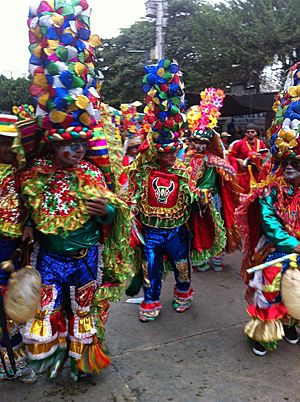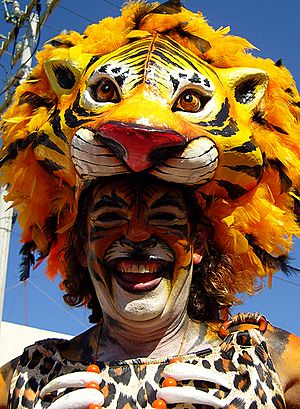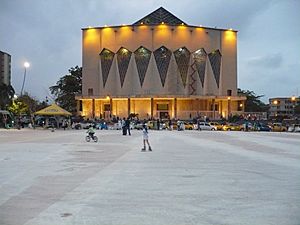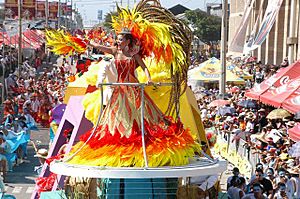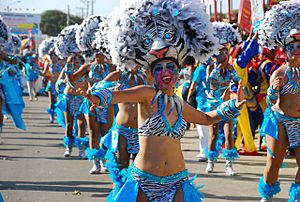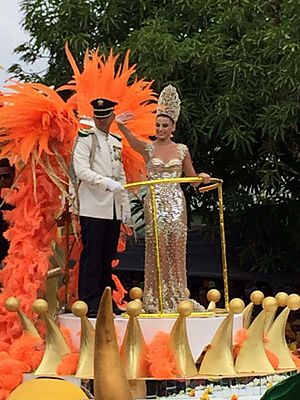Barranquilla's Carnival facts for kids
Quick facts for kids Barranquilla's CarnivalCarnaval de Barranquilla |
|
|---|---|
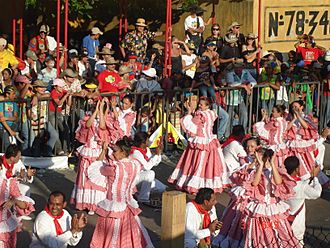
Folkloric groups dancing at the carnival
|
|
| Official name | Carnaval de Barranquilla |
| Observed by | Various locales, usually ones historically associated with Catholic populations. |
| Type | Local, cultural, catholic |
| Significance | Celebration prior to fasting season of Lent. |
| Celebrations | Parades, parties, orchestras festival |
| Date | Four days before Ash Wednesday |
| 2023 date | February 18 – February 21 |
| 2024 date | February 10 – February 13 |
| 2025 date | March 1 – March 4 |
| 2026 date | February 14 – February 17 |
| Frequency | Annual |
| Related to | Carnival SZ + ADP |
| Carnival of Barranquilla | |
|---|---|
|
UNESCO Intangible Cultural Heritage
|
|
| Country | Colombia |
| Reference | 00 |
| Region | Latin America and the Caribbean |
| Inscription history | |
| Inscription | 2003 (3rd session) |
| List | Representative |
The Barranquilla's Carnival (Spanish: Carnaval de Barranquilla) is one of Colombia's most important folkloric celebrations. It is also one of the biggest carnivals in the world! This amazing event has traditions that go back to the 19th century.
Four days before Ash Wednesday, the city of Barranquilla comes alive. Locals and tourists join together for four days of non-stop fun. During the carnival, the city's usual activities pause. Streets fill with dances, music, and colorful parades.
The Carnival of Barranquilla features many dances. These include the Spanish paleo, African Congo, and indigenous mice y mica's. You'll also hear lots of Colombian music, especially cumbia. Drums and wind instruments fill the air.
In 2002, Colombia's National Congress called the Carnival of Barranquilla a Cultural Masterpiece of the Nation. A year later, on November 7, 2003, UNESCO in Paris gave it another special title. They declared it one of the Masterpieces of the Oral and Intangible Heritage of Humanity. This happened when Olga Lucia Rodriquez was the Carnival Queen.
The Carnival officially begins on the Saturday before Ash Wednesday. This day features the Battle of the Flowers (La Batalla de Flores), a major event. On Sunday and Monday, you can see The Great Parade (La Gran Parada). There's also an Orchestra Festival with Caribbean and Latin bands. Tuesday marks the end of the carnival. It's announced by the burial of Joselito Carnaval, a fun, symbolic event where everyone pretends to mourn him.
Barranquilla's Carnival has a famous slogan: Those who live it are those who enjoy it (Quien lo vive, es quien lo goza).
Contents
History of the Carnival
It's a bit of a mystery exactly how and why this carnival started. Many people believe it's a way to welcome spring. It's also seen as a celebration of new beginnings and life. The carnival blends different traditions. These include ancient pagan ceremonies, Catholic beliefs, and diverse cultures. It's a mix of European, African, and Indian customs, dances, and music.
At first, it was a holiday for enslaved people. Over time, it grew into a huge celebration for the whole region. Local stories say it dates back seven centuries. Many traditions were brought to America by the Spanish and Portuguese.
A key moment in the Carnival's history was in 1888. This is when a character called King Momo first appeared in official records. In 1903, the first Battle of the Flowers was held. It was meant to bring back an old carnival tradition. Fifteen years later, in 1918, the first Barranquilla's Carnival Queen was chosen. She would lead the festivities. This tradition became official in 1923. As years passed, the carnival grew. New traditions, like the Great Parade, were added.
Important Dates in Carnival History
- 1888: King Momo became one of the main characters.
- 1899: The first Carnival President and Board of Directors were chosen.
- 1903: The first Battle of Flowers parade took place. This was to celebrate the end of the One Thousand Days War.
- 1918: Alicia Lafaurie Roncallo was chosen as the first Carnival Queen.
- 1923: The Carnival became an official event.
- 1967: The Great Parade event was introduced. It now happens on the second day of the carnival.
- 1969: The Orchestra Festival was created. This is a music competition with many different styles.
- 1974: The first Guacherna parade happened. This was thanks to Esther Forero's idea. The Guacherna is now celebrated the Friday before the carnival officially starts.
- 2002: The Colombian Senate declared the Carnival a National Culture Heritage.
- 2003: UNESCO officially named the Carnival a Masterpieces of the Oral and Intangible Heritage of Humanity.
Pre-Carnival Events
The carnival fun starts unofficially right after New Year's Eve. These early events are led by the carnival queen and the Momo King, chosen the year before. The official pre-carnival events begin with the Lectura del Bando. This is the reading of the Carnival Proclamation. After that, there's the "taking of the city" (la toma de la ciudad). Then comes the crowning of the Carnival Queen and the Momo King. There's also a children's parade, a gay parade, and finally La Guacherna. La Guacherna is a night parade and is considered the most important pre-carnival event.
The reading of the Carnival Proclamation is a very important pre-Carnival event. It officially kicks off the pre-Carnivals. This event usually happens at La Paz Square. The mayor of Barranquilla gives the city's keys to the carnival queen. This means she symbolically takes charge of the city during the carnival season. The proclamation is like a special "rulebook." It explains what people can and cannot do during the celebration. Each part of the proclamation includes fun and exciting news about the city. This encourages everyone to join the party. The queen reads it publicly during a folk show. She is joined by the Momo King, the children kings, and folk dance groups.
Crowning the Carnival Queen
The new Carnival Queen is crowned on the Thursday before the Battle of Flowers parade. During this show, the previous carnival queen places the crown on the new queen. It's a big party with lots of dancing and music. Today, it's held at the Romelio Martinez Stadium.
The tradition of crowning a queen started in 1918. Alicia Lafaurie Roncallo was the first queen. She was crowned at the old Barranquilla Club. Since then, a young woman from the city's upper class is usually chosen to lead the festivities. This has led to the crown often staying within a few families. This is mainly because the queen's family pays for many expenses, like her crowning outfit. This has been criticized because it can make it hard for young women from other backgrounds to become queen.
However, the official rules state that the queen is chosen based on her excellent dancing skills, charm, and carnival spirit. Eleven members of the carnival board meet privately each year to choose the queen. They pick her six months before the carnival starts.
The crowning show is a huge dance marathon. It's a big test for the carnival queen. She has to show off her dancing skills by performing many musical styles. These include cumbia, salsa, merengue, champeta, and mapalé. She dances with members of top carnival dance groups. National and international singers also perform, like Juan Luis Guerra in 2014. The queen's official carnival song is also presented at this event.
The Children's Parade
The Desfile del Carnaval de Los Niños is a special parade just for kids! School and community dance groups take part, along with the children kings and queens. You can see mini-floats in this parade, made just the right size for the children.
La Guacherna
La Guacherna is a night parade. It's considered the most important pre-carnival event. It happens on the Friday before the carnival officially begins. Many folk groups, cumbiambas, tamboras, and people in costumes join in. They parade by the light of candles and colorful lanterns.
La Guacherna unofficially started in the early 1900s in the Abajo neighborhood. Back then, during the pre-carnival days, people would call others to dance by playing a guache. This is a percussion instrument that sounds like a maraca. The dancing was joined by tamboras and flauta de millo. Candles lit up the night, making everyone joyful.
In 1974, this tradition was brought back. This was thanks to the music composer Esthercita Forero. She worked with Alicia de Andréis to get the carnival board to add it to the official program. Before that year, this parade didn't formally exist. It was named La Guacherna after Esther Forero, who helped create it.
The idea for a night parade came to Esther Forero in 1958. She saw a night parade in Santiago de Cuba. She learned that it started when many small groups gathered from across the area. She realized Barranquilla didn't have a night parade. When she returned home, she decided to create one. She named it La Guacherna. This name came from a childhood memory. She remembered cumbia groups rehearsing in the streets at night. People would say "a Guacherna is passing by." So, this big, bright night parade was created in 1974 and is still a highlight today.
The famous song for this event is also called "La Guacherna." It was composed by Esthercita Forero herself. The most well-known version is by the Dominican singer Milly Quezada.
Main Carnival Days
Saturday of Carnival: Battle of Flowers
The Saturday before Ash Wednesday is the first full day of Carnival. The celebration kicks off with the Battle of Flowers. This is the most important and most awaited event. It's a huge parade of floats. The Carnival queen leads the way, followed by folk groups, people in costumes, cumbia groups, and other dance groups. These are often the winners from the previous carnival's competitions. It's like Barranquilla's version of Pasadena's Rose Parade in the United States.
The Battle of Flowers is the oldest parade in the Barranquilla Carnival. It was first held in 1903. General Heriberto Arturo Vengoechea started it. He wanted a way to celebrate the end of the long Thousand Days War. This war had caused many deaths. With this event, the carnival, which had been stopped since 1900, started again.
At first, the Battle of Flowers was a stroll along an old path. Two groups of rich families rode in carriages decorated with flowers. Historian Alfredo de la Espriella said the first battle was a game. The two groups threw flowers, streamers, and confetti at each other. The "battle" ended with a peace gesture. Both groups made up and went to celebrate at a theater. It was so successful that they repeated it the next year.
Since 1991, the parade has taken place along Highway 40. Before that, it was on other streets. Now, the floats have loudspeakers. International and national singers ride on them, inviting everyone to celebrate and dance. Spectators used to watch on foot. Now, they sit in special boxes called palcos for a better view.
Sunday of Carnival: The Great Parade
The main event on Sunday is The Great Tradition and Folklore Parade (Gran parada de tradición y folclore). This parade is often just called the Great Parade. It happens on the second day of Carnival and started in 1967. Only traditional folk groups, cumbia groups, and dance groups take part. It also takes place along Vía 40 avenue. However, there are no floats in this parade. This parade truly shows the dance and music in their most traditional form. There are no big floats or loud speakers.
In 2013, about 300 dance groups participated. These groups are known as popular dancing groups. Examples include Caimán Cienaguero, Negritas Puloy, and devil harlequins. The music also stays very traditional. You'll hear lots of cumbias, chandés (often with the Garabato dance group), and fandangos (with the Marimondas dance group).
Monday of Carnival: Fantasy Parade and Orchestra Festival
Monday is the third day of Carnival. The two most important events are The Great Fantasy Parade and the Orchestras Festival.
- The Great Fantasy Parade
This parade features new and exciting dance mixes. It blends traditional styles with local and international rhythms. You'll see international music like samba, salsa, reggaeton, champeta, and electronic music mixed with local ones like cumbia, porro, mapalé, and merecumbé. This event attracts new and creative performances. A successful fantasy dance group can bring fresh ideas to the carnival. This helps it grow and become even richer. Over time, this parade has become one of the most popular events.
- Orchestras Festival
This is a big concert with many national and international music groups. It started in 1969. It usually begins early Monday afternoon and lasts until early Tuesday morning. In this festival, the music groups compete for a special award called the Congo De Oro. They compete in different categories. Each group must perform three songs. At least one song must be about the city of Barranquilla. This event is held at the Romelio Martínez Stadium.
Here are the categories where music groups can win the Congo de Oro prize:
- Tropical: This includes groups that play typical music from the Caribbean region and Barranquilla's Carnival. Examples are cumbia, porro, fandango, chalupa, and mapalé.
- Vallenato: This is for groups playing Vallenato music. It uses instruments like the accordion, caja, and guacharaca.
- Salsa: This category is for groups playing different West Indian music styles. These include son cubano, son montuno, pachanga, guaguancó, and mambo.
- Merengue: This is for groups playing music from the Dominican Republic and the Caribbean, like merengue.
- Urban music: This category is for groups playing "new styles" of urban music. These include champeta, reggaetón, hip hop, rap, and dancehall.
- Rescuing the Ours: This is for groups performing traditional folk music like cumbia, porro, fandango, chalupa, and mapalé.
Special awards are also given to the best musicians and singers in the competition.
This is the fourth and final day of Carnival. It's marked by the "death" of Joselito Carnaval. This event signals the end of the festivities. All over the city, people hold funny "burials" for Joselito Carnaval. He is a character who symbolizes the joy of the carnival. People say he "comes back to life" on Carnival Saturday. Then he "dies" on the last day, tired and happy, only to be "revived" for the next carnival.
Thousands of Barranquilla residents go into the streets to "cry" for Joselito. They put on funny acts. Joselito Carnaval can be a real person or a dummy. He is carried in a coffin or on a stretcher decorated with flowers. He is surrounded by his "crying widows." These "widows" can be men dressed as women! You might also see other characters like priests and orphans. No one is quite sure where this character came from.
Since 1999, the Barranquilla Carnaval Foundation holds a contest called "Joselito se va con las cenizas" (Joselito goes with the ashes). This encourages more groups to join this celebration. Awards are given for the best portrayal of the day and the winning group. The official group of mourners includes the current Carnival Queen and her princesses. They march first, followed by community mourners who perform for judges.
In the evening, a fun gathering takes place in the Abajo neighborhood or at La Paz square. People recite litanies, which are simple verses with a special rhythm. They use these to make funny comments or critiques about current events.
Carnival Venues
The main place for the Carnival is Vía 40. This is an industrial avenue where the Battle of Flowers (Saturday), the Great Parade (Sunday), and The Great Fantasy Parade (Monday) happen. Other important places include:
- The 17 road: For The King Momo Parade.
- The 44 road: For Guacherna.
- The Romelio Martínez stadium: For the Orchestras Festival and the Queen's crowning.
- La Paz square: For the Proclamation reading.
- Verbenas and closed dance rooms: These have live music and usually require a ticket.
Most parades can be watched for free. However, it's a good idea to buy a ticket for one of the bleacher seats to get a better view.
Verbenas
Verbenas are open, free spaces where people can dance, eat, and have fun. They are thought to have started in the early 1900s. Back then, friends would often surprise-visit someone's home. The homeowner was expected to welcome them and turn it into a party. These carnival dance gatherings were common among the middle-upper and upper classes. They were popular until nightclubs and hotels started hosting official dance rooms.
Some popular verbenas are:
- El Bambú, in the Olaya neighborhood.
- Polvorín, in the San José neighborhood.
- A Pleno Sol, in the La Unión neighborhood.
- La Gustadera, in the Las Nieves neighborhood.
- La Puya loca, in the Los Pinos neighborhood.
Donkey Rooms
These were semi-open rooms where people met to dance and have fun. They were free to enter. Their unusual name came from the fact that people would tie their donkeys to a post outside the room before going in!
Music and Dancing
The music of the carnival is a mix of many styles. These include cumbia, porro, mapale, gaita, chandé, puya, fandango, and fantastic merecumbés. These are all examples of different Colombian music styles.
The carnival is a party that brings together tradition and the creativity of the Colombian people. It's shown through many forms of dancing, music, and costumes. This variety makes it a unique and amazing party. The people themselves are the main stars. Every dance, every folk group, and every costume plays a part in making it the best show on Earth.
The Barranquilla Carnival is rich in different cultural expressions. There are traditional dances and choreographed dances. Comparsas are groups with live music that show off dance choreography and creativity. Comedies, like litanies, are traditional folk theater. These are groups that sing together. They can be individual or group acts, structured or dramatic.
Costumes and Dances
The Marimondas are the most popular costume. They are hooded figures with long noses, floppy ears, and bright trousers and vests. They look like a mix between a monkey and an elephant, dressed in vibrant colors.
Other traditional costumes include El Garabato, El Africano, Drácula, El Torito, El Congo, El Monocuco, Los Cabezones, Las Muñeconas, and El Tigrillo. Each costume has a special meaning. Many have Colombian roots and are very important to the people of Barranquilla.
The Carnival's dances are: La Cumbia, El Garabato, El Son de Negro, El Congo, El Mapalé, El Caiman, El Paloteo, El Gusano, Las Farotas, De Relacion and Las Pilanderas.
The cumbia is a great example of how Indian, Black, and White cultures have blended. It's a dance that shows a couple courting. The woman moves her hips elegantly and subtly to the rhythm of a drum, accordions, maracas, and flute. Another main dance is the Garabato. This dance represents a mystical battle between life and death. The Congo dance shows African tradition in its movements. It also reminds people of the history of slavery in America.
Queens of the Carnival
The Carnival Queen is a very important figure in the Barranquilla Carnival. She leads many of the events and represents the spirit of the celebration. The tradition of having a queen started in 1918 with Alicia Lafaurie Roncallo. Since then, a new queen is chosen each year to preside over the festivities.
Here are some of the Queens of the Carnival:
- 1918: Alicia Lafaurie Roncallo (The first queen!)
- 1919: Dilia Baena Lavalle
- 1920: Paulina Sojo
- ...
- 2015: Cristina Felfle Fernández de Castro
- 2016: Marcela García Caballero
- 2017: Stephanie "Fefi" Mendoza
- 2018: Valeria Abuchaibe Rosales
- 2019: Carolina Segebre Abudinen
- 2020: Isabella Chams Vega
- 2021: No Carnival (due to COVID-19)
- 2022: Valeria Charris Salcedo
- 2023: Natalia De Castro González
- 2024: Melisa Cure
See also
 In Spanish: Carnaval de Barranquilla para niños
In Spanish: Carnaval de Barranquilla para niños
- Carnival in Colombia
- Festivals in Colombia
- Masterpieces of the Oral and Intangible Heritage of Humanity
- UNESCO Intangible Cultural Heritage Lists
- Rijeka Carnival


